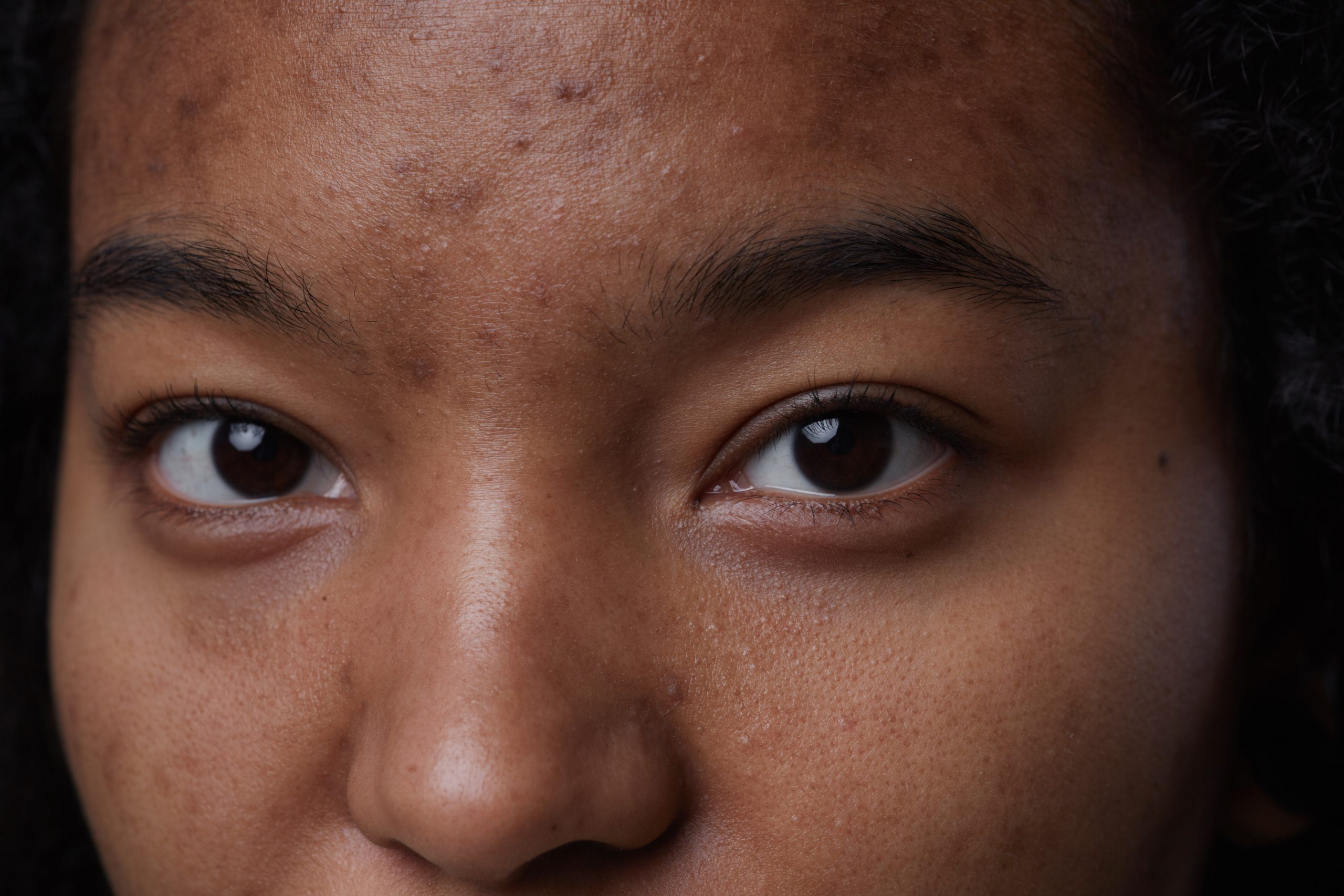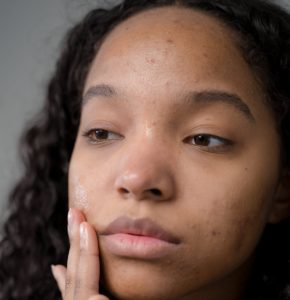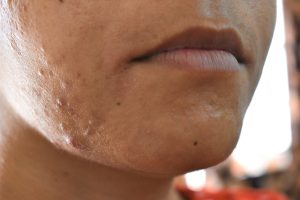
What you need to know about acne on Black skin
Author: Ramneek Dhami
Acne. Almost everyone has experienced it, and if you haven’t, you know someone who has. Acne is an extremely common skin condition and is one of the most common skin conditions in skin of color. Skin of color is black or brown skin. Acne is just as common, if not more common, in skin of color than in white skin. Here you will learn about what makes it more difficult for people with skin of color, and what treatments are specifically tailored to acne.
Recognizing Acne in SOC
First, it is important to determine the type and severity of acne that you have. This is something your dermatologist will determine at your first consultation. Acne can be distinguished by its type, such as comedonal (blackheads and whiteheads), nodular (firm, painful lumps), and cystic (deep cysts under the skin). Then, the number of acne spots are counted to determine severity. After the type and severity are determined, your dermatologist can develop a treatment plan specific to your acne.
In addition to the normal acne presentation, acne in skin of color has its own challenges. Acne in skin of color is more likely to leave behind post-inflammatory hyperpigmentation (PIH)- flat, darkly pigmented spots left behind after the acne itself has healed. This is often more difficult to deal with than the acne itself because the scars can last several months to years. Thus, your dermatologist will also determine the level of PIH that is occurring with your acne. Some people with black skin can also develop keloids, which are thick, disfiguring scars that are extremely difficult to treat. Luckily, there are medications that treat acne that can prevent these scars from forming in the first place, and medications/treatments that treat these scars as well.
Finally, there is also a type of acne that is more often seen in skin of color called acne cosmetica. This is caused by the hair products many people of color use, such as hair pomade and hair oil. This acne usually shows up on the forehead and temple area. If you use similar products and notice acne near your hairline or on the forehead, make sure to mention this to your dermatologist.
Hormonal Acne
Hormonal acne is acne that usually occurs before or during the menstrual period in women, and can include deep, painful cysts and nodules. Patients with hormonal acne can also experience irregular menstrual cycles, which can contribute to their acne. Usually, this type of acne can be treated with oral contraceptives (also known as birth control pills) and spironolactone. These can be combined with each other, and with antibiotics if the acne is more severe. These medications work by decreasing the hormone production that leads to increased levels of sebum, the oily substance that causes acne. Importantly, spironolactone can only be used in women due to its hormone blocking effects, and is not recommended for use in pregnancy. On the plus side, spironolactone can be used to replace chronic antibiotic use in women. This medication can provide great relief and results.
Retinoids and SOC
Retinoids are vitamin A like molecules that come in a variety of different formulas, like gels and creams. Some common retinoids are adapalene, tazarotene, and tretinoin. It is important to treat the acne before scarring and hyperpigmentation can occur, so retinoids are especially useful for this purpose. However, they also help with treating hyperpigmentation from previous acne. When using retinoids, you might notice that the acne will improve first. With long-term use, hyperpigmentation will begin to improve, so do not give up on retinoids! Retinoids can also be combined with non-retinoid treatments. Side effects can include peeling, dryness, redness, and overall irritation of the skin. Some formulas (like gels) can be more irritating than others, so it’s important to let your dermatologist know if you have sensitive skin. It is important to prevent more irritation than needed, because too much irritation can worsen hyperpigmentation.
Accutane and SOC
Accutane, also known as isotretinoin, is an oral pill that has been used for severe, nodulocystic acne. Accutane is actually underused in skin of color and is safe and extremely effective. The treatment course is usually 5-6 months. A low dosage can be started at first and slowly increased to prevent the acne flare that commonly occurs shortly after starting the medication.
Accutane is the only acne medication that has a long term benefit for acne after patients finish their treatment course. Most people who have been on Accutane before rarely or never experience acne again, with an 85% cure rate.
It has a wide range of side effects and should not be used in people that can get pregnant, unless they are using 2 forms of contraception. Accutane is extremely harmful to fetuses and causes serious birth defects. Patients are required to sign up and adhere to iPledge, a government regulated system specifically for the use of Accutane. Labs are monitored before starting the medication and every 2 months to check organ function, but this usually does not affect the treatment course. Common side effects include skin dryness and irritation, anxiety and depression, muscle/joint/bone pain, headache, and increased thirst and urination. It is important to maintain a gentle skin care routine and use a moisturizer during accutane treatment.
Overall, Accutane is the single best and most recommended treatment for severe acne with hyperpigmentation. Make sure to ask your dermatologist about Accutane and have a conversation regarding its side effects and benefits.
Chemical Peels and SOC
Chemical peels use molecules like glycolic acid or salicylic acid to remove the top layer of the skin and encourage new, fresh skin to regenerate and improve skin texture and tone. They can be used alone for mild acne, or in combination with other treatments for more severe acne. Not only do they target acne spots, these peels help treat the hyperpigmented spots leftover from previous acne spots and are especially useful for scarring. They even help other treatments work better by increasing absorption of topical treatments. Usually, these peels are a series of 3-6 treatments, each treatment 4 weeks apart. However, medium-deep (using TCA) and deep chemical peels (using phenol) can worsen hyperpigmentation. It is important to talk to your dermatologist to determine if chemical peels are the right treatment for you.
Microneedling and SOC
Microneedling uses tiny needles to stimulate your skin to produce more cells and collagen. This technique is the most effective for deeper acne scarring, but not for acne spots themselves. Microneedling provides the best results when combined with other treatments and improves the results of other treatments, but can improve scars on its own. Microneedling is a safe option that provides improved scarring with little to no risk, making it best to use in patients with dark and sensitive skin types. It is important not to use microneedling in combination with anticoagulant medications (commonly known as blood thinners), active skin infections, use of collagen injections or fillers within the last 6 months, or personal/family history of keloid scarring.
General skin care for acne:
Using a gentle cleanser and cleansing with clean, washed hands (not those rough scrubbers you see in stores!) is a great first step. Try to find one catered to your skin type, whether that be dry, combination, or oily. Next, find a moisturizer that is gentle and works with your skin. Lastly , find a sunscreen that is at least SPF 30 that you enjoy using, and make it a habit to start using this every day (re-apply every 2 hours if you can). Sunscreen can really help prevent and improve the pigmented spots from previous acne!


